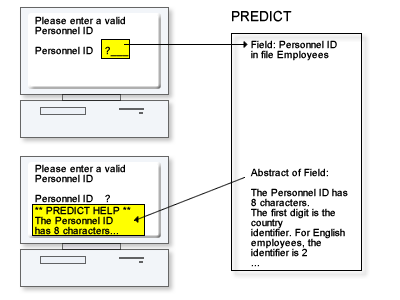Predict offers a variety of functions reducing the effort necessary to implement an application.
External data definition objects generated by Predict and stored in Predict can be maintained with administration functions.
Generation functions are described in the section Generation in the External Objects in Predict documentation.
Section Administration of External Objects in the External Objects in Predict documentation describes how external objects are administrated.
This document covers the following topics:
Natural processing rules can be generated from verifications objects. If a DDM has been generated from a file containing fields with verifications linked via is verified by VE, and processing rules of status automatic have been generated from any of these verifications, Natural will automatically apply the processing rule to a map.
Processing rules are stored in the Predict system file for use by Natural.
See the section Verifications and Processing Rules in the Predict and Other Systems documentation for a detailed description of how processing rules are generated and maintained.
Natural data definition modules (DDMs) can be generated from Predict file objects. Generated DDMs are stored in Predict.
Where to find Detailed Information
See DDMs in the section Generation in the External Objects in Predict documentation.
Two types of external objects are distinguished:
external objects owned by Predict
external objects not owned by Predict
The main differences between the two types are listed below.
See the section Handling of External and Documentation Objects in the External Objects in Predict documentation for more information.
External objects owned by Predict are stored in Predict and are administered exclusively with Predict functions.
External objects not owned by Predict are stored in the application environment and could be administered with utilities of the application environment. However, administration of external objects stored in Predict with utilities of the application environment is not recommended.
External objects owned by Predict are dependent on the Predict documentation objects from which they were generated: if the documentation object is deleted, the generated objects are deleted as well.
External objects not owned by Predict are not deleted automatically if the documentation object is deleted.
External objects owned by Predict are in card format or Copy Code. External objects of these types are mainly used at compile time.
Most external objects not owned by Predict are implemented in the application environment. External objects of these types are mainly used at run time.
The following types of external objects are owned by Predict:
3GL Copy/Include Code (C, COBOL, Assembler, FORTRAN, PL/I)
Adabas invert, compression and security definitions (ADAINV, ADAWAN/ADACMP/ADAFDU, ADASCR)
Transparency Table for Adabas Bridge for VSAM.
SQL CREATE statements
There are different options to output generated external data definition objects of the above types:
External objects can be generated temporarily (option 1)
External objects can be stored as members in a Natural library of the Predict system file (option 2). Objects can then later be punched to the application development environment.
External objects can be stored additionally in a workfile or - with Entire System Server - as an operating system member (option 3)
See Storage of External Objects Owned by Predict in the section Generation in the External Objects in Predict documentation.
The following types of external data definition objects are not owned by Predict: they belong to an application (development) environment.
Databases (Adabas, DB2, IMS/DL/I)
Vista translation tables
DB2 tablespaces and storagegroups
Files, tables and views (Adabas, Adabas SQL, DB2)
Natural for DL/I user defined fields (UDFs)
Natural DDMs (including Natural security definitions and/or Super Natural files).
Predict connects external objects and documentation objects if an external object has been generated from a documentation object or - vice versa - a documentation object has been incorporated from an external object. Connecting external and documentation objects helps ensure the consistency of the documentation and an application: documentation objects and - to a certain extent - external objects that are connected are protected from being deleted or modified.
Where to find Detailed Information
See the section Generation in the External Objects in Predict documentation.
The connection of external objects and documentation objects affects the following functions:
Administration: external objects connected to documentation objects can be protected.
Maintenance: Predict protects documentation objects that are connected to an external object from being purged accidentally.
Comparison: to compare an external object and a documentation object, both have to be connected.
External objects and documentation objects can be disconnected with the administration functions Disconnect implementation and Purge implementation.
See the section Administration of External Objects in the External Objects in Predict documentation.
External objects owned by Predict need not be connected: because these types of objects can only be administrated with Predict functions, the consistency with documentation objects is not endangered.
Predict provides a user-modifiable, generally applicable help facility: routines that make data stored in dictionary objects available as help information both at function level (map, program) and at field level.

Any combination of the following information stored with Predict objects can be displayed in help screens:
The abstract and extended description of a map, field, database, file relation and system.
The abstract, extended descriptions and permitted values of verifications linked to a field via standard link verifies EL.
See the section SYSHELP in the Predict Reference documentation.